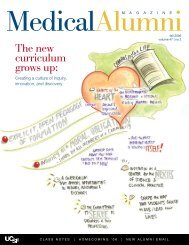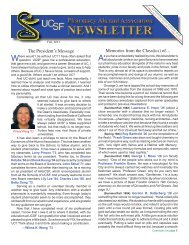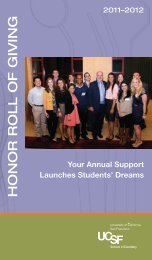here - UCSF Alumni
here - UCSF Alumni
here - UCSF Alumni
You also want an ePaper? Increase the reach of your titles
YUMPU automatically turns print PDFs into web optimized ePapers that Google loves.
PROFILE: ROBERT WACHTERHealing Patients and Health Care SystemsBy Elizabeth Chur“ Growing up Jewish in the New York suburbs, thefirstborn son of a socially climbing family, I thinkyou begin thinking about medicine in utero,” saysRobert Wachter, MD, with a chuckle. “The tension for mewas that I was a politics junkie, and found myself muchmore drawn to reading about politics and history than Iwas chemistry or biology.”Wachter, an international leader in the patient safetyfield, grew up on Long Island, the oldest of three children.His father ran a women’s clothing company started by hisgrandfather, an immigrant from Poland. In high school,Wachter volunteered at a local hospital and found mentorsamong the physicians. Although he wanted to become adoctor, he joined the debate team and majored in politicalscience at the University of Pennsylvania.“I enjoyed trying to understand how things wereorganized – how complex enterprises moved and changed– how people were motivated to do their work better,which is what you study in political science,” says Wachter.“I always thought I would have these dual lives: one as aphysician, and then I would come home and read theNew York Times. It never dawned on me that I would havea career w<strong>here</strong> I could combine those two interests.”He went to medical school at Penn, w<strong>here</strong> he founda mentor in John Eisenberg, one of the nation’s firstMD/MBAs. “He was a great doctor and teacher, but hisresearch involved thinking about the health care system:how we pay, how it’s organized, and how the work force isconstructed,” says Wachter. When Wachter came to<strong>UCSF</strong> for his internship and residency, he met StevenSchroeder, MD, then the founding chief of the Divisionof General Internal Medicine, who went on to lead theRobert Wood Johnson Foundation. “T<strong>here</strong> seemed to bea niche for people who had these dual parts of their brain,”says Wachter. “That was an epiphany for me.”Founding a new specialtyIn 1995, Lee Goldman, MD, then the chair of theDepartment of Medicine, appointed Wachter to run theinpatient medical service. “Lee always was looking toimprove systems, and charged me with finding ways tomake our medical service better,” Wachter says.Thus emerged the “hospitalist,” a term that Wachterand Goldman coined in a 1996 New England Journal ofMedicine article. Like orchestra conductors, thesehospital-based specialists oversee all the elements of ahospitalized patient’s care – lab reports, medication lists,reports from surgeons, specialists and others – andweave together the big picture, making connectionsbetween disparate pieces of information and ensuring thatthe whole patient receives the best care possible.In 2007, Wachter was named chief of the Division ofHospital Medicine. The growth of the hospital medicinefield has been astonishing: the Society for HospitalMedicine now has 7,000 members, and the AmericanHospital Association estimates that t<strong>here</strong> are more than20,000 practicing hospitalists in the United States – makingthis one of the fastest growing specialties in the history ofAmerican medicine.“As a new field, we were branded in part as being aboutsaving money,” says Wachter. “But it seemed to me that themodel should also improve the quality of care.” He waspresident of the Society of Hospital Medicine when the1999 Institute of Medicine report was released, stating thatup to 98,000 patients a year are killed annually by medicalerrors. “A light bulb went off, and I said, ‘We need to be atthe forefront of making this better.’”Putting it all together“One of my mantras is that all hospitalists have two sickpatients,” says Wachter. “One of them is the person in thebed, and one of them is the building that we’re working in.Both are in intensive care, and both need a lot of help andexpertise. It’s our job to fix both.“T<strong>here</strong> were already people focusing on silos withinpatient safety: information technology, diagnostic errorsand medication safety,” says Wachter. “Part of this is mypolitical science background, and part of this is mygeneralist mindset: I like to be the person who sees the bigpicture and explains things in ways that are accessible.”He has spent much of his career doing just that.In addition to publishing six books and 200 articles,Wachter edits the federal government’s two leading patientsafety websites (webmm.ahrq.gov and psnet.ahrq.gov).He also has his own lively and accessible blog (www.wachtersworld.org).“I have the world’s best job,” he says. “I get to be aphysician, teacher, mentor, writer, speaker and administrator– and to do it in a great organization with wonderfulpeople who have terrific values. Every day I feel like I’vewon the lottery. I don’t ever tell anybody this, but if I couldfigure out how to live, I’d probably do it for free.”medical alumni magazine | 7
















